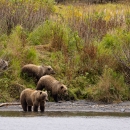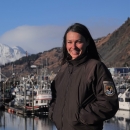Surveys of mountain goat abundance have been conducted annually by the Alaska Department of Fish and Game and Kodiak Refuge biologists since 1975. Although survey effort has varied over the years, from island-wide counts to partial surveys, results provide baseline data on historical goat population growth, kid recruitment, and range expansion.
Eighteen mountain goats (7 males and 11 females) were introduced to the Hidden Basin region of Kodiak Island, from the Kenai Peninsula, in 1952 and 1953. By 1964, the population reached 26 animals. The first hunting season was authorized in 1968 when the population was estimated to be at least 71 animals. Goats were lightly harvested initially because of a restrictive draw hunt and limited areas that were open for hunting. The population increased through the 1980’s from 150 to over 400 animals. Permits changed from a draw hunt to a registration hunt in 1984 and 1985, but resulted in high hunter densities, less harvest selectivity, “herd shooting”, and wanton waste (Smith 1986). Drawing system regulations were reestablished the following year, and remained in place throughout the 1990s. The mountain goat population continued to grow throughout the 1990s, and ADF&G responded by opening new areas on Kodiak to hunting. Hunting permits were issued for the first time in the southern portion of Kodiak in 1991, and a new hunt area close to the road system was opened in 1995. By 1999, the population increased to an estimated 1,000 animals, and goats were believed to occupy all available habitats on the island. Hunt areas encompassed all of Kodiak and Uganik Islands in 2001, and a new hunt area in the northern portion of the road system was opened. In 2001, the Kodiak-Aleutian Regional Advisory Council (KARAC) received a proposal to include Kodiak mountain goats as a federally-listed subsistence resource, and to open Federal lands to subsistence hunting by permit. A joint (Kodiak Fish and Game Advisory Committee and KARAC) working group formed to discuss ways to meet subsistence needs of rural residents, while retaining state harvest management. The Board of Game approved a proposal from the working group to increase the maximum number of drawing permits from 250 to 500 and establish registration hunts after the drawing hunts, if allowable surpluses of goats exist. This regulatory change halted efforts by the Federal Subsistence Board to create a subsistence mountain goat hunt. In 2009, the state of Alaska approved more aggressive harvest management measures (registration hunt) in a segment of the population receiving lower hunting pressure (Hunt Area 480) because of limited floatplane accessibility. The population was estimated to be approximately 2,500 animals in 2010 (ADF&G, unpublished data).




